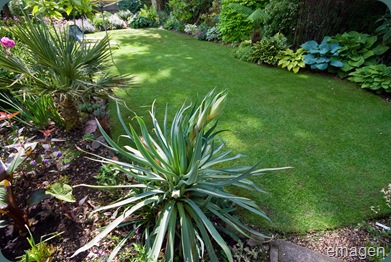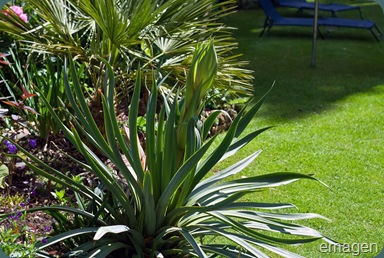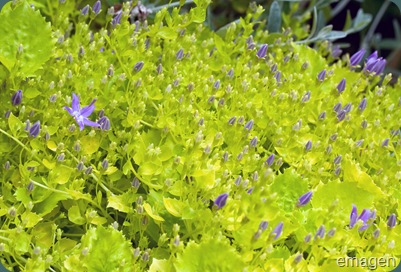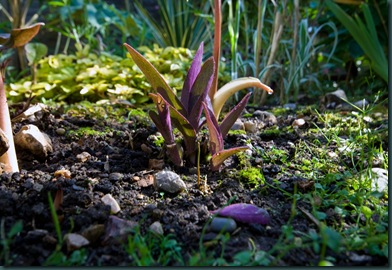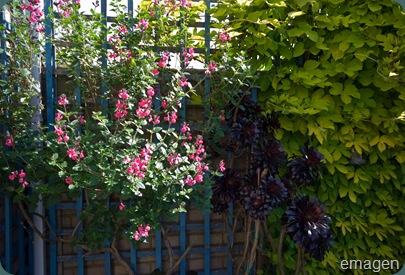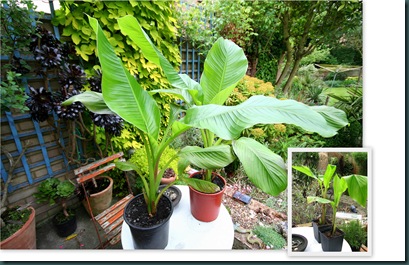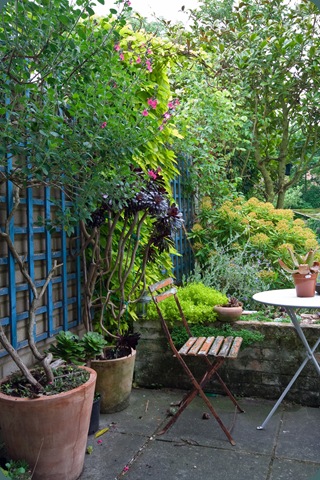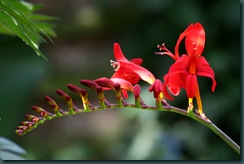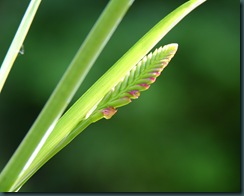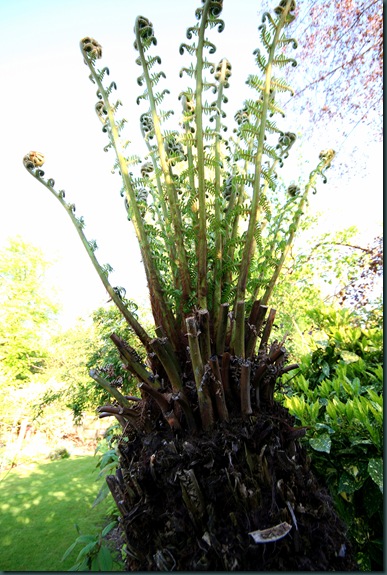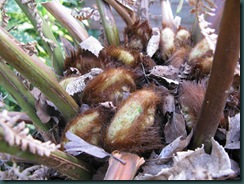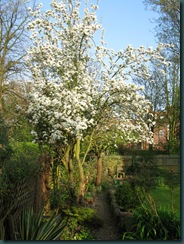'Musa' is the link between my attempts at growing tropical plants amongst other more 'normal' plants, 'Musa' being the botanical term for the banana genus, and the name of a mountain close to where we holiday in Turkey - Musa Dag. This blog will be mainly about the garden and its plants including attempts at growing bananas, colocasias etc. here in the UK. Other subjects may/will creep into this blog including holidays in Adrasan, music, food and other meanderings.
Farwell!
It has been an experiment and one that has been enjoyable, to a point. But, I have learned a lot and will we back one day. Perhaps a blog on the subject of stoats or something more specific - I don't know. Certainly, there are far better and knowledgeable people than me on the subject of plants and gardens and I have failed to add the intended wit to make this blog interesting. 'Work' is bad enough without adding another burden and that is what it has become - "What shall I write" - "I should write something".
So, goodbye and thanks to anyone who found interest in my meanderings.
This blog will stay open for the next few weeks and then I will delete it.
Rob
Under Hostas towards Black Bamboo Canes

Under Hostas towards Black Bamboo
Originally uploaded by emagen
Further to my previous post, I took this photograph with the camera underneath some hostas looking towards Phyllostachys nigra (Black Bamboo). I think the black canes show up well and you can see the emerging new shoots.
I've been experimenting with taking photographs from underneath plants. Some of the results can be seen on my Flickr photostream in my 'Underplants' set. (Follow the link next to the above photo.)
New Bamboo Shoots
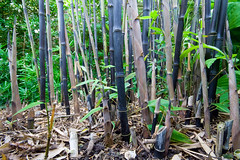
New Bamboo Shoots
Originally uploaded by emagen
The new shoots of Black Bamboo or Phyllostachys nigra are thrusting upwards from the ground.
This year it looks like the new canes are going to be up to 3/4 inch in diameter. The width of each new shoot will be the same as when it is fully grown (if that makes sense!). Last years new canes were not particularly thick or numerous. I'm not sure why this year should be a more productive year as I have not changed the way I cultivate the plant.
Every year, in the autumn, I put a thick layer of rotted compost from the heap all around the canes. In the spring I apply liquid feed and ensure the soil is kept moist. Throughout the year I cut out any small canes in order to keep the clump from becoming too chocked. I always remove the lower branches from each new cane as it grows (I call this 'shaving its legs'). Removing the lower branches makes the black canes more visible although it is important to note that the canes do not turn black until their second year. I'm not sure if removing the lower branches does the plant any harm but its canes are now over 12 feet high so it seems quite healthy.
I grow Phyllostachys nigra in dappled shade and I think this prevents it wandering too far although this year some of the new shoots seem to have travelled quite far.
Beschorneria yuccoides about to flower
It is with a certain amount of sadness that I have to announce that my Beschorneria yuccoides plant is about to flower.
I’ve grown this plant for a number of years and I really, really like it. It looks a bit like a Yucca but despite its looks, it does not have sharp spikes on it hence it can be grown close to a path. I like its geometric shape and its blue/grey/green leaves.
The flower bud looks enormous and I’m surprised that there are another two buds developing.
The flower spike should reach 6ft and, I’ve read, should be quite spectacular. I’ll probably (almost certainly) post a picture when it actually flowers.
So, why am I so sad? Because, after flowering the main plant will die! OK, so there are now small baby plants around the base but it will take some time for these to grow and I will need to separate them – I think the plant looks best growing as a solitary specimen.
Its been a good plant and I will miss it.
Garden, June 3rd 2009
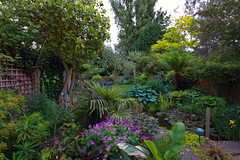
Garden, June 3rd 2009
Originally uploaded by emagen
Photograph of the top part of the garden taken late evening yesterday. Every day there is something coming into bloom. The garden is still in Spring mode with the 'big stuff' yet to make a mark. Mind you, my bananas are having to start from ground level this year.
Hosta - Sun and Shade
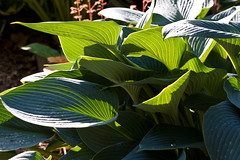
Sun and Shade
Originally uploaded by emagen
I can't resist adding this photo to the blog. As I've said before, I'm hopeless at making notes of or remembering the names of all the different Hosta in the garden (about 40).
But this time of year is probably the best time for Hostas, they look fresh and, if you are lucky, not too full of slug holes.
The photograph was taken in the early evening with the sun shining through the blue-green leaves showing up the veining.
Campanula garganica 'Dickson's Gold'
Campanula garganica 'Dickson's Gold' (Adriatic Bellflower) is just beginning to flower and I think the plant looks best when it is in bud. The emerging blue buds look really great amongst the almost yellow leaves and create a sort of haze effect. I can’t resist trying to get a decent photograph of it and my Flickr site has many attempts on it.
I grow this plant on a narrow wall bed in a fairly sunny site and the extra height plus it being just outside the glass back doors enable it to be seen. Of course, I have to admit, I didn’t think of this when I planted it 10 years ago – it just turned out to be a lucky placement.
Campanula garganica 'Dickson's Gold' is a low growing, rock garden, perennial type of Campanula. I have several other ‘rock garden’ types but they tend to be invasive as does garganica but this ‘Dickson’s Gold’ variety behaves itself very well. My plant now covers about 3 square feet and is about 3 inches high. This variety has the added advantage of its bright yellow-green leaves that give interest even when the plant is out of flower.
Tradescantia pallida 'Purpurea'
I am surprised to find that Tradescantia pallida 'Purpurea' has made it through last winter unaided.
I’ve always thought of this plant as a houseplant and, therefore, tender. I originally bought the plant as part of my experiments of growing so called ‘houseplants’ as summer bedding. It is planted in a bed that houses bananas, a palm and Colocasias and has survived for the last 3 years but I was certain last winter’s cold would kill it.
I noticed, at the weekend, that it had survived and below is a photograph of new shoots rising from the soil.
I’ve since read that Tradescantia pallida 'Purpurea' is actually supposed to be quite hardy so I have learnt something! I also now know that it is sometimes referred to as Setcreasea pallida ‘Purpurea’. I also now know that the plain green leaved form is an invasive weed in Australia.
Anyway, the plant looks tropical and most unlikely to survive the UK climate, hence it goes well in a tropical planting of bananas and the like.
Pond May 2009

Pond May 2009
Originally uploaded by emagen
The pond is now full of life. The big goldfish (Wattle), the breeding herd of minnows, the newts and the tadpoles are all competing for food and probably eating each other.
A wide selection of birds use the pond for drinking from and bathing in the shallow areas. The blackbirds behave more like 'waders', stalking tadpoles and fishing them out to eat.
The minnows are definitely breeding and I hope there will soon be baby minnows or perhaps they are called 'fry'. Last year there didn't seem to be any babies and I think this could either be due to the newts eating the eggs or me cutting back the rampant waterlily which may have had the eggs on. In previous years the minnow herd has reached vast numbers but a visiting kingfisher keeps the numbers down.
I dug the pond about 9 years ago and it is amazing how quickly frogs and newts have colonised it.
The plants and ferns around the edge are now in full leaf. The last plant to come into full leaf has been the Rodgersia (seen centre-right of the photo).
Maintaining the pond is quite time-consuming particularly in early spring when pond weed and algae grow quickly. It gets easier in the summer, I guess because the waterlily cuts down the amount of sunlight and inhibits the growth of pond weed.
I never intended to have goldfish preferring a more natural pond but my late father bought me a pair of them. I called them Wattle and Daub, sadly Daub died a couple of years ago leaving Wattle to get fat alone. My wife thinks I spoil Wattle! But I think she is just jealous. Wattle is a true friend.
Colocasia esculenta emerging

Colocasia esculenta emerging
Originally uploaded by emagen
The photograph is of a leaf shoot of Colocasia esculenta emerging from the soil (taken today). I'm quite surprised how well these plants manage to overwinter without protection. I always keep some plants / tubers in my temporary plastic greenhouse but I lose most of them to rot. I think I will give-up over-protecting them and let them take their chances outdoors. If they can survive last winter then I need not worry.
Having said that - Was last winter really that bad? Sure, we had snow but not really that much and winter seemed to start earlier. But I'm sure my pond spent less time covered in ice than the year before and the year before that. Also the better Spring weather started earlier and we have not had any damaging late frosts.
I'm sure my bananas would disagree though. Where once stood mighty bananas to 12ft, now there are only new shoots emerging from the ground.
Is Your Tree Fern Dead?
I know from my stats page that many people find their way to this blog to seek advice on their Tree Ferns and in particular Dicksonia antarctica. It seems that Tree Ferns all over the UK have suffered due to the very cold winter. The questions people are seeking an answer to include:
- Is my Tree Fern Dead?
- My Tree Fern has no fronds.
- How do I know if my Tree Fern has died?
- My Tree Fern has only a few fronds.
- Why has my Tree Fern not got many fronds?
- Should I cut off dead fronds?
I do not claim to be an expert on Tree Ferns (or anything else for that matter) – so I set off on the Interweb to see if I could find answers to the above questions. I found lots of expert advice on the cultivation of Tree Ferns including how to protect them over winter. But I could not find anything about cold-damaged Tree Ferns or any advice on how to nurture a frost damaged Tree Fern back to life, if indeed, that is possible. For myself, I would like to find advice on what to do about my smaller Tree Fern that has, so far, only put up 2 new fronds this year.
So if there is an expert out there who knows some of these answers please could you use the comments section at the bottom of this posting to share your wisdom.
I have 2 Tree Ferns (Dicksonia antarctica), one 6ft tall and the other 3ft tall. The tallest one is quite exposed to both wind and sunlight and despite losing all its fronds to frost has now put up 20+ new fronds. The shortest one is more sheltered from the wind and sunlight and even has a tall bamboo growing next to it giving increased shelter but this one has only put up 2 new fronds so far this year. Both had some dry leaves and fronds stuffed over their growing point. It seem then that size must be an important factor in getting through a cold winter.
My smallest tree fern, the one in trouble, seems to have either some dead coils of fronds at its heart or somehow the growing area is blocked by the stems of dead fronds. I wonder if some of the cause of my problem is that some of the fronds have been killed by the frost before that were able to naturally bend outwards and downwards away from the centre of the central well of the trunk? I wonder too if dead, embryonic fronds are similarly blocking the central well and stopping the development of new fronds?
I think my non-expert advice for anyone wondering if their Tree fern is dead is:
- To not assume death and continue to keep the trunk moist. Perhaps there is a chance of recovery.
- To not cut off dead fronds unless absolutely sure that there is no life in them.
Sorry that I can’t be of more help but perhaps an expert will give us
some advice.
Salvia microphylla ‘Cerro Potosi’, Aeonium ‘Zwartkop’ and Humulus lupulus 'Aureus'
Salvia, Aeonium and Hop (left to right). Picture taken this morning.
At the risk of continuing to be boring . . . . . Salvia ‘Cerro Potosi’ . . . . what a fantastic plant / shrub! I keep trying to get a decent photo, I can do OK on getting a good shot of individual blooms but can’t seem to get a shot of the entire shrub that does it justice. Above is yet another attempt! The plant pictured is in a large pot just outside the backdoor which means that you brush against it, releasing the scent of blackcurrants from its leaves. It grows in other parts of the garden plated in the soil and is very, very hardy. It flowers from April to November and only requires some pruning to stop it becoming too scruffy.
Also in the shot are Aeonium ‘Zwartkop’ and the yellow-leaved hop, Humulus lupulus ‘Aureas’.
The strong winds have abated and there has been some warm sunshine. Everything is growing with vigour!
For the first time for many years, I’ve treated the back lawn with weedkiler. The lawn has large amounts of moss in it and since treatment the moss has turned black. I now have a sort of black lawn! Think I may have made a mistake!
May Evening
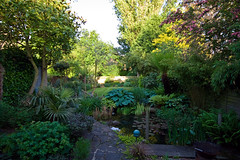
May Evening
Originally uploaded by emagen
I'm really fed-up with this blustery weather. It feels cold although the temperatures are quite reasonable. The garden is taking a battering from the wind and its not comfortable to be out there, particularly in the evening. The pond continually needs leaves and other debris cleared from the surface. Pots get blown over. I want to plant out some of the taller plants but fear they will get damaged by the high winds. I can't even be bothered to walk to the pub (now that's serious!).
But the forecast says it is set to improve and get warmer! Most plants seem to be growing well, there are new shoots of Musa sikkimensis and of Colocasia esculenta. Dahlia 'Bishop of Llandaff' is appearing above ground. The ginger plants are starting to shoot. Wattle - the big goldfish - is eating again. The roses are in bud and . . . . actually all is well.
The photo, taken this evening, shows the garden looking quite lush. The big leaved stuff are yet to make their mark and soon a shot down the length of the garden will not be possible.
Sunshine and Showers
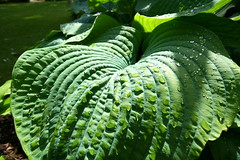
Hosta leaf after the rain
Originally uploaded by emagen
To be precise: 'Showers and Sunshine'
The weather is not great, squally winds and showers of rain. Yesterday I bought some plants, the 2 Ensete 'Maurelii' (mentioned in the previous post) and some other odds and ends including a couple of Ricinus communis. The bronze leaved Ricinus communis usually self-seeds around the garden but I thought getting a couple of established plants would be a 'head start'. Interesting to note that Ricinus communis is the true 'Castor Oil Plant' rather than Fatsia which is often given this name. Ricinus has large bronze leaves (if you get the right variety) and interesting seed pods, the plant adds to a tropical / exotic effect.
Anyway, the rain has stopped and the sun has come out - I don't know for how long. The photograph was taken yesterday of a Hosta leaf after a rain shower.
Ensete ventricosum ‘Maurelii’ in stock at B&Q!!!
This is not an advert for B&Q but if you want to grow the Red Leaved Banana - go and get one now.
They have 2 sizes, the largest being plants about 2ft high at £10 each. Ensete ventricosum ‘Maurelii’ used to be difficult to find and only ever available at specialist nurseries. I remember when I first started growing it, I travelled 150 miles to the nearest stockist. Unlike the green Ensete, it can’t be grown from seed nor is it so hardy.
Anyway, if you want a stunning tropical plant for your garden – buy now while stocks last!
Ensete ventricosum
Update on young plants . . . . .
Back in March (the 4th to be precise) I posted a description and photo of 2 young Ensete ventricosum or Abyssinian banana plants that I had purchased from the ‘Lost World Nursery’ via eBay. As can be seen in the photo below, they are both growing strongly now. I’ve inset the original photo taken back in early March.
The plants are still spending most of the time indoors but as soon as the weather improves, they will go outside permanently and the be planted in the ground.
They are the ordinary green variety of Ensete and in many ways I prefer them to the red-leafed variety, they are stronger growers and easier to overwinter. This year they will make quite sizeable plants but I will dig them up in November and keep them somewhere frost-free over winter. Next year they will be enormous!
Backdoor
The wind has dropped to nothing, it’s very overcast but not cold. I wandered around the garden this evening with camera looking for inspiration for this blog. I took some photos of hostas, of bamboo and some more ‘general’ shots. The low light made the photos look a bit gloomy and not very sharp so I gave up and retired inside for dinner and wine.
Sitting at the dinner table, I gazed out upon Salvia ‘Cerro Potosi’, an Aeonium (or two) and hops (Humulus lupulus ‘Aurea’) clambering up the trellis outside the window / door. I think it’s the yellow/green leaves of the hop and magenta flowers of the Salvia that made the scene look a whole lot brighter than the gloom of the rest of the garden. The almost black rosettes of Aeonium ‘Zwartkop'’ added contrast.
So I took a photo! I should be sitting in that chair enjoying a warm summer evening – maybe soon!
As I’ve said before Salvia ‘Cerro Potosi” is a fantastic plant, flowering from Spring to Autumn and happy in virtually every situation and completely hardy. I like to plant it where one is forced to brush against it, releasing the scent of blackcurrants from its leaves. I have to control the hop otherwise it would smother the Salvia and the Aeonium.
By the way – How many spellings of ‘Zwartkop' (as in Aeonium) are there? I’m currently using this spelling but it doesn’t feel right.
Cold east wind
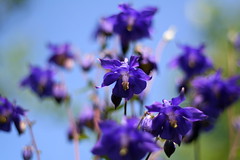
Aquilegia flowers
Originally uploaded by emagen
Long day at work. Very strong easterly gale all day. Although rain is predicted, I watered some of the plants in the garden this evening a the strong winds are, I think, very drying. The tree ferns particularly needed water.
The Ensete ventricosums are still kept indoors although they are getting quite big now, they go out in the daytime if the weather is good but as soon as the weather gets better they will go out permanently.
The photo is of some self-sown Aquilegias taken at the weekend when the weather was better.
Tetrapanax papyrifera 'Rex' (and a hand)

Tetrapanax papyrifera 'Rex'
Originally uploaded by emagen
I mentioned in an earlier post this Spring, that I was pleased my Tetrapanax papyrifera 'Rex' (or Rice Paper Plant) had survived the winter and was making new leaf shoots.
Now, I few short weeks later it is producing massive leaves, the photograph, taken yesterday, shows the hand of the author to give scale.
The plant is situated in a sunny place but in a bed more suited to plants that like dry conditions. I would like to move the plant to a better location but fear losing it. A comment from a reader of the earlier post suggested that it was reasonably easy to strike cuttings and I think I will give this a try.
Its Monday and back to work. There's a howling, cold east wind. Not a good day!!
Dicksonia antarctica
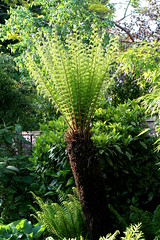
Dicksonia antarctica
Originally uploaded by emagen
And finally on the subject of ferns, an update on the Tree Ferns.
The Tree Fern in the photo (taken today) is busy making new fronds and influencing people. Despite losing all its fronds in the winter, it has sent out a large number of new ones and looks very happy.
My other, shorter Tree Fern does not look so healthy. I am used to the smaller Tree Fern sending up very large fronds and has always looked very healthy since planted 5 years ago. This year, although also losing all its fronds during the cold winter, I was not worried. Early in the Spring I could feel its coiled fronds within the central well.
But so far it has only sent up 2 new fronds and these seem quite weak, I can feel that there are other fronds ready to go but these feel smaller than usual. It could be due to the cold winter or, I wonder, if it is due to the dry Spring. In the last couple of weeks I've ensured that the trunk is kept moist and hope that this will do the trick.
Judging from the numbers of people finding this blog in answer to a Google search on why their Tree Ferns have died, it seems that this is a problem throughout the UK.
It also seems that the taller your Tree Fern the hardier it will be.
Dryopteris wallichiana

Dryopteris wallichiana
Originally uploaded by emagen
I'm still on about ferns! This time Dryopteris wallichiana or Wallich's Wood Fern.
This fern's new fronds are just coming up, (photo taken today). The new fronds unfold more than unfurl. Its bright green fronds contrast well with its hairy, black stems.
I grow this fern in almost complete shade and it gets largely hidden by other plants and forgotten. But it is a great joy when you re-discover it amongst all the other planting.
Dryopteris buschiana, (aka crassirhizoma)
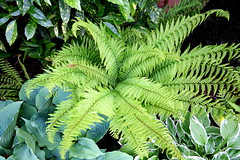
Dryopteris buschiana, (aka crassirhizoma)
Originally uploaded by emagen
Keeping on the fern theme, I've been growing this fern for 3 years and it is really looking good now! (Photo taken today) Known variously as Dryopteris buschiana or Dryopteris crassirhizoma its common name is the 'Thick Stem Wood Fern'.
This fern is now growing to about 3ft high and has a lovely light green colour and grows through the summer with an erect shuttlecock style. In winter it keeps its fronds but they lay down at ground level to protect any offspring, I guess. I believe this fern hails from Asia but it seems to be perfectly hardy here in the UK.
The colour size and shape of this fern makes it seem quite tropical, I grow it in semi-shade amongst other ferns and hostas at the base of a tall Tree Fern. In fact, I will have to cut-back some of its neighbours to give it space.
I have always bought ferns as very young plants (I think that's the only way) and some turn out to be quite boring and difficult to tell apart from basic 'ferns'. Dryopteris buschiana or crassirhizoma has turned out to be a real 'star'.
Athyrium otophorum 'Okanum'
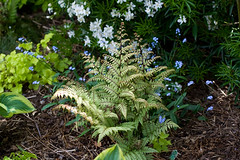
Athyrium otophorum 'Okanum'
Originally uploaded by emagen
This fern has the wonderful common name: 'Eared Lady Fern'. I wonder how often the adjective 'eared' is ever used? I don't think I have have ever heard anyone describe anything as 'eared'. Certainly I can imagine that a lady without ears would be called 'ear less' but to describe someone (or a lady) as being 'eared' would seem too obvious an attribute as not to require remark or description. I guess owls might be described as 'eared'? Oh well!
Anyway, I've posted this picture of Athyrium otophurum 'Okanum' (taken yesterday) not because of its ears but because it is just such a beautiful fern. It is a native of Japan and is perfectly hardy in the UK, growing to about 18 inches, its colours are striking and has delicate fronds. It is a deciduous fern and looks particularly good at this time of year.
By the way - had a really good birthday dinner last night with my wife (eared) and eared daughter.
Yellow Poppies
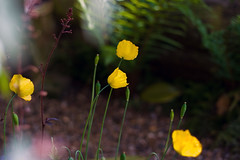
Yellow Poppies
Originally uploaded by emagen
Before I head off for my birthday dinner, I thought I'd post this photo of yellow poppies taken with my new lens. I've forgotten the name of the variety (its an age thing) but will add it when I remember. I rather like the photo, I'm not sure why.
I'm always wary of poppies as they have a propensity to self sow all over the place. This yellow species is quite easy to control, it pops up here and there and usually finds just the right place for itself. Any unwanted seedlings / plants are easily removed unlike some of its cousins.
Now for dinner!
Birthday!
Naturally I haven't refused any birthday presents! Amongst other stuff, I received a new 50mm prime lens for my camera. Which was nice.
I took a photo with my new lens of the lens box (seemed like a good idea).
This evening I am going to a really good restaurant with Mrs Musa and our daughter. Gin & tonic, wine, brandy and something to eat.
Crocosmia
I’ve had a large clump of ordinary Crocosmia which I inherited when moving here. The clump has gradually been shaded by other plantings and recently has not produced many flowers. I actually quite like the leaves but midway through the summer it looks a mess. The worst thing, though, is the way this ‘ordinary’ Crocosmia spreads, I have had to continually restrict its ambitions to take over the world. The trouble is that messing with this plant ends up with spreading its small bulbs everywhere particularly if you get any of it in the compost heap.
So, at the weekend I decided to get rid of it once and for all. I couldn’t believe the amount of bulbs it had underneath it! I sifted all the soil to try and remove every last bulb, it took me all afternoon and I bet I didn’t get every bit. I now have two large sacks of bulbs for the public tip, I certainly won’t put any on the compost heap.
I also have Crocosmia ‘Lucifer’ but this is a very well-behaved plant and does not spread so much, it is a valued member of my garden’s plant life. The flowers are a deeper red than the basic orange-red and much larger.
The photo above is of Crocosmia ‘Lucifer’ flowers and below a photo of its buds (which I rather like). Taken last July.
A walk in the woods, Bluebells
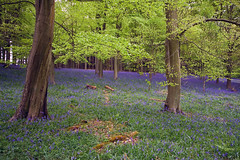
A walk in the woods, Bluebells
Originally uploaded by emagen
Having driven through these woods over the past couple of weeks and thinking that I really should take my camera and get a picture of the Bluebells, I've actually done it!
I have a small corner of my garden where Bluebells grow, mainly because it is a difficult area and I've yet to plant more exciting plants. I don't mean that Bluebells are not beautiful, certainly their flowers are. But in a small urban garden I need plants that have a longer season and don't leave masses of decaying foliage through the summer. OK, I'm not a great 'bulb person' and that's because, with work, I only really get to enjoy the garden during the summer.
I think Bluebells are best seen in wooded areas such as Kings Wood where they completely carpet the ground under the (mainly) coppice woodland.
I wonder at the vast amount of stored energy that must lay just a few inches below the surface.
By the way - walking must be one of the most natural things for humans to achieve. Why then did I pass several people walking with what looked like ski poles? Am I missing something? Or perhaps they are simply wearing the wrong shoes!
Ferns and Hostas, Garden May 09

Ferns and Hostas, Garden May 09
Originally uploaded by emagen
I took a photo early this morning while the sun was low of a group of ferns and hostas. I always think ferns and hostas go so well together.
The fern in the foreground is Polystichum polyblepharum and the one in the background is Dryopteris buschiana, both are just completing unfurling their fronds. I'm afraid I don't know the names of the Hosta varieties.
I always remove the old fronds of these ferns before the new growth emerges. I'm not sure if this is the right thing to do but it allows one to see the new fronds unfurling and keeps the plant neater and fresher looking. Anyway, the ferns don't seem to have suffered from this practice.
At the moment, this is the most interesting part of the garden. Other parts of the garden will require a few more weeks to come into their own.
Gardening Shoes

Gardening shoe
Originally uploaded by emagen
Today I want to talk to you about shoes. Yes . . . .Shoes. In particular - gardening shoes.
"Why write about shoes", I hear you say. Well, gardening shoes need to fulfill several key criteria in addition to normal, everyday shoes. It is not enough for them merely to protect your feet from treading on dog poo or to just keep your toes from splaying outwards. The following points should be borne in mind when adopting a pair of shoes to become 'Gardening Shoes':
The key criteria is that they should be able to be slipped off ones feet when entering the house and be able to slipped on when entering the garden. Both these actions should be able to be achieved without bending down.
They should be comfortable to wear with or without socks. ( Even in the privacy of one's garden, wearing socks with shorts does not do much for one's self-image).
They should be waterproof.
They should NOT have any tread. I know some people favour wearing walking-type boots but this type of footwear has deep treads that trap soil and then distributes this soil in clods around the lawn or on paths. Trainers are definitely no good, their tread traps pieces of grit that sound really annoying when walking on garden paths. (Trainers are also garish, smelly things). Wellington boots have similar 'tread problems and look silly with shorts.
My gardening shoes, pictured above (well . . . one of them) fulfill all the above criteria apart from them no longer being waterproof. I've had them for many, many years. The laces are now purely decorative and in a permanent knot, they can be very easily slipped on and off without bending down. They are, in fact, so loose om my feet that I've had to adopt a particular way of walking so that they don't fall off. The gait I have to adopt is rather similar to that of a cross-country skier!
I wear these gardening shoes all the year round except for the summer months when I attempt to walk barefoot in the garden. Walking around barefoot is a pure joy for most of the time but I have suffered some nasty injuries from this practice!
Echeveria about to flower
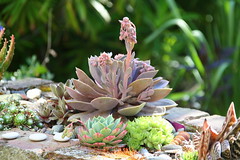
Echeveria about to flower
Originally uploaded by emagen
I am really pleased with how some of the Echeverias etc have come through the winter, some with a piece of plastic covering them, others with nothing.
The photograph shows Echeveria 'Perle von Nurnberg' just coming into flower surrounded by Sempervivums, another Echeveria and Aloes. These plants are grown in a narrow, brick-built raised bed, fairly close to the house, in very gritty, free-draining soil.
Whilst I like big, bold plants, I also find the form and symmetry of succulents very appealing. It is also amazing how such, seemingly, tender plants can survive outside in our climate.
I have an Opuntia cactus that has survived outside in a pot without protection. I'm now looking for a place to plant this out permanently in the garden but it will have to be somewhere sheltered and somewhere where its needles cannot attack people!
Mayday Mayday

Across the pond
Originally uploaded by emagen
Day off work!
Glorious weather. Shorts weather!
Day spent - thinning bamboo clumps - planting plants - training hops - weeding weeds - watering pots - sitting in the sun - watching newts and tadpoles - feeding fish - looking at plants - watching the white-headed blackbird.
And . . . . a long weekend to come!
Photo of across pond early this morning.
Only a brief post - it's shorts weather!
Tree Fern progress
Dicksonia antarctica very much alive.
I’ve noticed from the blog counter data that many people have found this blog as a result of a search on the topic “is my Tree fern dead?”
So this is a photo taken this evening of the new fronds (croziers) on my tall Tree Fern. ( a poor photo).
It has been a cold winter and all the fronds on my Dicksonia’s were killed by the frost. But the tallest Tree Fern is making rapid progress, perhaps too rapid? There seems to be about 30 new fronds coming up and that could mean that each frond will be small or that it is a sign that the whole tree feels threatened and might be on its last legs.
Meanwhile, the small tree fern has only just started to show new growth. I have been keeping the trunks damp by watering them as up until the last few days, it has been very dry weather.
Osmunda regalis 'Purpurascens'

Osmunda regalis 'Purpurscens'
Originally uploaded by emagen
This photo of an emerging frond (croziers) of Osmunda regalis 'Purpurascens' was taken a couple of tears ago but shows exactly this fern's growth today. This fern's common name is the Purple-stemmed Royal Fern and, by rights, should be grown in damp ground in dappled shade. I grow mine under a very large tree in almost full shade of course! I, therefore, need to water it quite frequently but it does look good in the company of: Hosta 'Frances Williams' ; Smyrnium perfoliatum; Geranium macrorrhizum and Ligularia dentata 'Desdemona'.
All the ferns in the garden, including the Tree ferns, are now rapidly growing, sending up new fronds.
I would have posted a photo taken today but since the sunny weekend it has been wet & cold and I have been lazy!
Colocasia
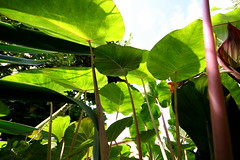
Under Colocasias 2
Originally uploaded by emagen
Another survivor of the cold winter!
Although I have over-wintered some Colocasias in pots in my temporary plastic greenhouse, I'm pleased to note that there are signs of new shoots from those plants that were left 'in the ground'.
I know one is supposed to overwinter Colocasias by keeping their tubers in a cool dark place much like you are supposed to over-winter dahlia tubers. But I never have much success finding it difficult to get the correct environment I either end up with a rotten, mushy mess or dried, shrivelled dead tubers.
The over-wintered pots are now standing outside and doing quite well but I really welcome those plants that have survived alone and outside.
Whereas I used to have about 4 or 5 different varieties of Colocasia, I think I now am left with only the basic Colocasia esculenta. I may try and find some other varieties, probably on-line, to add some variation in the theme.
The photograph shows Colocasias last summer that had over-wintered unprotected. I tried a bit of an 'arty' shot from underneath the leaves!
Rushing past the Bluebells

IMG_3358
Originally uploaded by emagen
On the way to the plant sale today, we went through Challock Forest aka Kings Wood. I drive this road quite a lot and at this time of year think that I must make time of to go walking in the woods and take some photographs of the Bluebells. I've yet to do the walk but took this photo from the car and I rather like the blurred image of trees and Bluebells as we drive past.
NCCPG Plant sale, Godinton House
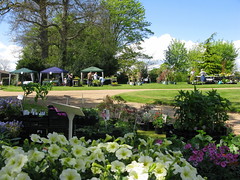
IMG_3378
Originally uploaded by emagen
Went to the local NCCPG (National Council for the Conservation of Garden Plants) at Godinton House near Ashford today.
A beautiful house with enormous gardens and grounds. Who can live in a place like this?
There were about 16 small, specialist plant nurseries there, the sun shone, it was warm, I bought plants. I bought Geraniums Heucheras, Hostas, an Echeveria and 2 Aloes. The Aloes look interesting although they are not named - I shall have to do some research.
I plan to plant the Aloes straight into the garden despite the advice of the seller. Live dangerously!
Musa Sikkimensis is alive!
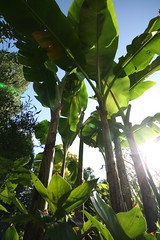
Musa Sikkimensis
Originally uploaded by emagen
My Musa Sikkimensis is not dead!
I've been growing this banana for about 8 years. When I can be bothered I wrap the stems in fleece after the first frosts, other times I just let it fend for itself and it has come through the winter. Last autumn I was too lazy to wrap it up and justified this by the fact that it had come through the previous winter 'unwrapped'. The stems were reaching 10ft tall and they were 9 inches in diameter at their base, it was a magnificent plant and, I have to admit, I was rather proud of it. But this past winter seemed to have finally killed it off! The dead and rotten stems collapsed leaving nothing.
I've kept quite quiet about my loss and have been feeling rather ashamed of myself and, of course, bereaved. I've peered at the rotten stumps in the vain hope of finding new growth. How could I even have a blog named 'Musa' if I don't have any Musas!!
Good news! Just half an hour ago in what I assumed would be another fruitless search for new growth, I found a strong new shoot emerging from the ground!! We are back in business!
I've found that new shoots grow quite rapidly and I expect (hope) there will be more than one. I've tried growing Musa bajoo in the past but I thought it not as hardy as Musa sikkimensis, perhaps I was right.
I've decided to go out tonight to celebrate although I'm not sure if any of my favorite restaurants will have a table.
The photo above was taken last summer.
Time to think of buying plants
I've continued this evening to patch various bald areas of lawn from the grass I cut when widening a border at the weekend. It is a great joy to be able to come home from work and be able to do an hour or so in the garden before it gets too cold or dark. I've been tidying-up after the winter, removing dead growth and tackling the weeds at the back of the borders, this year I've waged war on Ivy - not sure who will win!
I'm beginning to think of buying new plants, my favorite options are:
- The plants fairs run by the Hardy Plant Society or the NCCPG (National Council for the Preservation of Garden Plants). Both these organisations run small local plant fairs that attract small specialist nurseries. These nurseries offer plants not usually found in garden centres but best of all they offer a wealth of advice and information as well.
- The big DIY chains often sell large specimens of palms and tree ferns etc. at low prices. They also sell loads of houseplants which are always worth experimenting with as a sort of summer bedding.
- Specialist exotic / tropical plant nurseries either to travel to or to access on the Internet.
Macleaya cordata
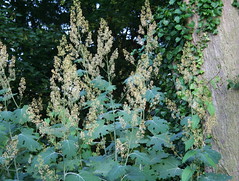
Macleaya cordata
Originally uploaded by emagen
Beautiful spring day today, sunny and warm, although I didn't get to see a lot of it being stuck in an office all day.
I noticed this evening that the Macleaya cordata is now growing rapidly. This plant, common name Plume Poppy, makes a striking architectural feature growing to about 9ft with large, deep-cut, grey / green foliage. It carries sprays of buff coloured flowers atop its high stems.
This plant is 'as tough as old boots' but looks quite exotic and I find is great for the back of the border in difficult situations. I grow it at the back of a deep border at the foot of a very large tree, it has to deal with often dry and shady conditions. It's height is very useful in disguising a 6ft high fence and it easily outdoes some nasty weeds that live in the vicinity. Grown in better conditions, Macleaya might be difficult to control. The foliage always looks fresh, at least until it dies back to the ground in late autumn.
Definitely a plant I would recommend - if you have the space.
Ensete ventricosum 'Maurelii'
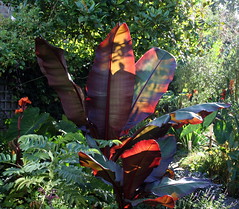
Red Ensete in the morning sunshine
Originally uploaded by emagen
This is the red form of the Abyssinian banana, Ensete ventricosum. The colour of the leaf is fantastic and can grow very large. 'Maurelli' is not as hardy as the basic green form and cannot be grown from seed. But never fear, you can now buy young plants in places like B&Q and Homebase in the UK, they should be available any time soon. I find it best to grow the plant in a pot for the first year then attempt to overwinter it somewhere frost free. In the second year I plant it out and it will produce a massive plant but, I find, it is then too big to dig up for the winter and it will die.
This year my timings are all wrong and I don't have any plants for planting out, so I'm waiting for them to become available again.
This year has been a bad year for bananas for me, largely due to my laziness and bad planning!
This photograph was taken the summer before last, this plant was standing about 10 ft tall and there is even my shadow on one of the leaves.
Tree Fern making new fronds!
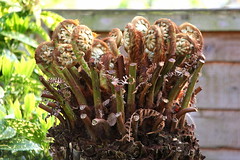
Making new fronds!
Originally uploaded by emagen
As I have had vast numbers of people contacting this blog concerned that last winter (UK) had killed-off all their Tree Fern's fronds and fearing for the very survival of their plants, I thought I would post this photo, taken today, of one of my Tree Ferns making new fronds.
This particular Tree Fern is quite exposed and has had no protection from the cold. A smaller Tree Fern of mine is in a much more sheltered position but its new, coiled fronds are, as yet, barely visible.
So, I hope all Dicksonia antarctica's will have survived the cold winter.
Here's to old and new fronds everywhere!
Garden Archaeology

Garden Archaeology
Originally uploaded by emagen
Whilst widening a border and digging-up some of the lawn, I came across an unusual object. I carefully scraped away the soil using my trowel and gently lifted the object. I was able to identify the object as a toy car! As the toy car was under the lawn, I can positively estimate its age to be at least 10years old! This being the time we have lived in this house and the lawn has been there since we arrived. I'm unable to identify the exact model and age and am considering seeking expert advice as to its age and value.
Whilst digging the same border, I was fortunate in uncovering another piece of garden archaeology. I found a very ancient pair of secateurs! This find did not come from under the grassed area so I don't have any evidence of age. But I can identify them as secateurs once sold by a chain of shops called Woolworths (long since defunct).
My theory is that years ago some idiot threw the secateurs onto a compost heap along with a pile of prunings. Later the compost, along with the secateurs, was dug-out and spread on the border only to be discovered years later by me (the idiot)!
I wonder if any other gardeners have found similar 'interesting' things?
Philadelphus coronarius 'Aureus' flowers
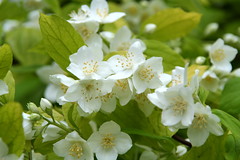
Philadelphus coronarius 'Aureus' flowers
Originally uploaded by emagen
As in my previous post I talked about Philadelphus coronarius 'Aureus', I thought I'd post this photo of its flowers taken last May.
Phyllostachys nigra with Philadelphus coronarius 'Aureus'
Looking out of the window through the rain at the Philadelphus, I thought the canes of the Black Bamboo contrasted well with the yellow leaves. So I braved the rain to take a photo:
France Trip
We went to stay with my sister and brother-in-law at their house in deepest Dordogneshire. We call their place Chateau Magimix, I'm not really sure why!
The first photo is of Chateau Magimix itself. From here their land stretches down a steep hill with flower borders at the top giving way to a large grassed area with plenty of trees.


The grassed area is partly mowed but with large areas left to grow as meadows into which they have introduced a variety of flowering plants. I supposed they are not, strictly speaking, meadows due to the introduced plants.
The meadow areas look great in the early morning sunshine when still covered in dew. The next two photos show plants in the meadow areas including dandelion which seems to be growing everywhere in this part of France this year.

The last photo shows me in my role as gardening advisor!

Musings
It’s been back to work today after over a week off. The weather has been quite good but with a cool breeze and only hazy sunshine. So, on my return home I went to look at how things are doing in the Musa acres. Truth to tell, there is nothing very astounding!
The thousands of tadpoles in the pond seem to be doing a very good job of clearing algae from all the rocks and and stones. I’m not sure if this is a good thing and wonder if it will upset the balance of the pond life. The herd of minnows are very hungry and I have to crush the pond-stick fish food into minnow bite-size pieces. My last remaining goldfish, Wattle (he used to have a friend called Daub) has been skulking under some vegetation, hardly moving and not eating. I’m quite worried about him, he is quite old (and very big). But when I give him a prod, he dashes off on a tour of the pond and looks and swims quite healthily.
On Sunday I took down and packed away for the summer the temporary plastic greenhouse. All the former inmates are now placed close to the house wall in their pots. Their numbers include a couple of Brugmansias both with large flower buds. I just have to hope that there will be no more frosts.
On my recent trip to the Dordogne Region of France, I noticed that this Spring seems to be the year of the Dandelion – they were everywhere, some fields looking almost completely yellow. I’m sure that there has been an abnormally large number this year. I’ll put-up a photo of what I mean in my next post.
Dicksonia antarctica, Beschorneria yuccoides, Adiantum venustum and pear tree blossom. Signs of Spring!
As I’ve been saying for the past few weeks, Spring is definitely making its mark. Here are a few examples of what’s happening in my garden with photographs taken this evening:
Dicksonia antarctica
In this photograph you can clearly see the new fronds of this Tree Fern ready to unfurl. After such a cold winter and all last year’s fronds dying off, it is good to see new growth.
Beschorneria yuccoides
The Beshorneria yuccoides is still looking a bit tatty but has come through the winter very well. I’m sure it will flower this year which will be a bit of a shame as the main plant will die. I read, though, that the flowering process is quite spectacular.
Adiantum venustum
This fern’s common name is the Himalayan Maidenhair. This photograph shows its bright green new fronds. It seems to be one of the first ferns to get going again in the Spring. I’ve planted this delicate-looking fern in a couple of place in the garden in quite sunny positions and it does very well, gradually spreading to form a low clump about 1 ft high, it is also fairly easy to control.
Pear Blossom
Finally, I’ve included this photo of the pear tree in full blossom, lit by this evening’s last rays of sunshine. We never manage to harvest much of the fruit but I’ve a mind this year to try brewing or distilling some ‘hooch’ from it!
